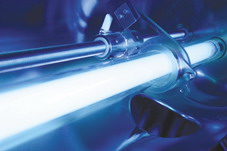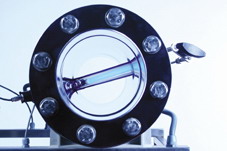Hanovia UV has recently cooperated with the largest natural drinking water company in the country to protect its highest quality drinking water. This means that the production of bottled water industry will enter another height. In the production process, the treatment of green environmental protection and no negative products should be used as much as possible to maximize the taste of natural water and protect the original ecology of water.
It is understood that more and more bottled water companies are now seeking such a safe way of disinfection, not only because of the recent hot issue - the carcinogenic negative product bromate of ozone disinfection, many domestic excellent bottled water producers Including the largest natural drinking water enterprise in China, there is no problem of bromate. However, from the long-term development of the company, reducing the safety hazards and ensuring the original ecological perspective of the water, it has turned to a green and safe water treatment method such as ultraviolet disinfection. .
Most mineral water or natural water sources contain bromide ions, which are themselves non-toxic and harmless. However, in the presence of ozone, ozone, a strong oxidizing substance, oxidizes bromide ions to form bromate, a carcinogen defined by the International Health Organization. The latest national standard also limits it to below 10 ppb. On July 4, 2008, the China Quality Supervision, Inspection and Quarantine Bureau revised the national quality standards for drinking water and mineral water. In this revision, it is recommended that the maximum value of bromate in mineral water is 0.01 mg/L. This new regulation has been implemented since October 2009.
As an alternative and/or complementary means of ozone disinfection, UV disinfection has many unique advantages. It has been widely used in food and beverage manufacturing enterprises worldwide, and has been widely used in other industries with high water quality requirements, such as the pharmaceutical industry. Ultraviolet light kills all known microorganisms, including bacteria, viruses and molds (including spores) without producing any disinfection negatives. It is a low maintenance, environmentally friendly disinfection technology that ensures the highest level of disinfection while reducing People rely on chemical disinfectants.
Worldwide, most bottled water and soft drink manufacturers have begun to use safe UV disinfection technology to avoid a series of problems caused by ozone or other chemical disinfection.

Depending on the UV lamp used (low pressure lamp and medium pressure lamp), UV disinfection technology is mainly divided into two types.
How to sterilize ultraviolet rays
Ultraviolet light is the part of the electromagnetic wave between visible light and X-rays, which is 185-400 nm in its spectrum. Among them, ultraviolet light (also called UV-C) between 240nm and 280nm has a strong bactericidal effect, and the highest sterilizing efficiency is 265 nm. Ultraviolet rays destroy the DNA by invading the cell membrane of the pathogen, causing them to lose their ability to reproduce and kill them effectively.
A typical UV disinfection system consists of an ultraviolet lamp, a quartz sleeve, a stainless steel processing chamber, and a control system. The water to be treated flows in at one end of the chamber and flows out through the other end of the chamber. In fact, any water source can be effectively treated with ultraviolet light, including spring water, surface water and municipal treated water, RO water, viscous syrup and industrial wastewater.
Depending on the UV lamp used - low pressure tube and medium voltage tube - UV disinfection technology is mainly divided into two types. The low-pressure lamp has a monochromatic UV output (whose wavelength is limited to 254 nm), while the medium-pressure lamp has a multi-color UV output (with a wavelength range of 185-400 nm). In general, low pressure systems are best suited for small flow and intermittent flow liquids, while medium pressure systems are more suitable for high flow, high flow applications.
The benefits of UV disinfection
UV disinfection has many advantages over other methods. Unlike chemical disinfectants, UV does not produce toxicity, does not contain any residue and various by-products, and does not alter the taste, odor or pH of the water.
UV sterilization can be used to initially sterilize water or as an alternative to other purification methods such as carbon filtration, reverse osmosis, or pasteurization. Since there is no residue in UV disinfection, it is best to place the system in front of the water outlet so that the microorganisms in the water flowing into the water supply system are completely destroyed and no longer contaminated after treatment. Danger.
UV disinfection in the bottled water industry
Source of raw water
Although springs and mineral waters usually do not contain harmful or pathogenic microorganisms, this is not absolute. Water removed from wells, rivers or lakes may be contaminated and must be disinfected.
CIP rinse water
It is important that the CIP rinse water used to rinse off foreign bodies and disinfectant solutions is sufficiently safe to be microbiologically safe. A fully automated UV disinfection system can be combined with a CIP rinse cycle to ensure that the final rinse water is not contaminated with microorganisms again. For this application, medium voltage lamps are ideal because of their high mechanical strength and are not affected by sudden changes in CIP water temperature. For example, after rinsing with hot water at 80 ° C, it is then rinsed with cold water at 10 ° C.
Filter disinfection
Reverse osmosis (RO) concentrates and granular activated carbon (GAC) filters are breeding grounds for bacteria. For reverse osmosis concentrated water and granular activated carbon filtered water, ultraviolet light is an effective method for disinfecting it, and has been widely used in the processing industry.
Dechlorination
The water is often dechlorinated using a particulate activated carbon filter to remove the odor generated after the chlorination treatment, so that the resulting water has a good mouth feel and has no unpleasant taste. The addition of an ultraviolet system in front of the dechlorination activated carbon filter can improve the working efficiency of the activated carbon filter and prolong the use time of the activated carbon, thereby reducing the cost.
Packaging and surface sterilization
Surface sterilization systems are often used to reduce the microbial count of all packages, including glass and plastic bottles, cans, lids and foils. If these packages are irradiated with UV light before filling, the various pathogenic organisms can be eliminated, thereby extending the shelf life of the product and reducing the risk of spoilage.
syrup
The syrup used as a flavoring agent is often the best thing that breeds microorganisms. Although syrups with high sucrose sugars are not conducive to microbial growth, once the syrup is diluted, the dormant spores will multiply. If these syrups and dilution water are sterilized with an ultraviolet disinfection system before the syrup is used, it is possible to ensure that the dormant spores are revived.
Disinfection of the air at the top of the storage tank
For pressure tanks or pressure pipes that store easily degradable liquids, an ultraviolet sterilization system can also be used to sterilize the pressurized air. Storage tanks are particularly susceptible to bacterial growth and contamination by spores carried by the air. To prevent this from happening, an immersion UV sterilization system was designed, mounted on the top of the can, and sterilized at the top of the air.
Disinfection and / or reuse of wastewater
UV disinfection systems can treat wastewater flowing out of process equipment without the use of chemicals that are harmful to the environment. This ensures that all wastewater discharges meet local environmental regulations. As mentioned above, since the wastewater flowing out of the equipment can be reused by the treatment of the ultraviolet sterilization system, the amount of waste water generated in the production process is greatly reduced.
case study
Angel Springs Limited, UK
Angel Springs Responsibility Co., Ltd. is located in the UK's Chiltern Hills, which produces natural bottled mineral water. A few years ago, the company replaced the previously used ozone disinfection unit with the UV sterilization system produced by Hanovia. The company's decision to make this change was to worry about the bromate produced during the ozone treatment.

If the package is irradiated with ultraviolet light before filling, various pathogenic organisms can be eliminated.
“Because bromate may be produced during the ozone treatment process, we no longer use ozone for disinfection,†said Andrew Glasgow of Springs. “Although the amount of bromate in our water source is not very high, for safety reasons, we have chosen to use an ultraviolet sterilization system.†Mr. Andrew Glitter added a note. “The UV sterilization system has no disadvantages, only advantages. Since the installation of it, we have been very satisfied with its performance. As long as the UV lamp is replaced after every 8000 working hours, it is very efficient.â€
The source of Angel Springs Responsibility Co., Ltd. is the local natural spring water. After physical filtration to remove solid particles, it is sterilized by ultraviolet irradiation chamber, and then can be filled. In addition, there is no further water treatment and no chemical treatment is required.
in conclusion
In the bottled water industry, how to meet increasingly stringent health standards has become a serious challenge. This is especially true when the China Quality Supervision, Inspection and Quarantine Bureau is going to implement regulations on bromate content. Customers also want to stop using chemicals to process the water. If you need to improve the factory and equipment, you need to make the investment in this area as soon as possible, and improve the quality of the product.
For manufacturers who are trying to improve the quality of their final products, UV sterilization systems are an economical and reliable option. It is a good and effective way to disinfect drinking water, which has been proven around the world. It is also widely used in industries that require high purity water, such as the pharmaceutical and semiconductor industries, where the water used is of the highest quality.
The UV disinfection system is easy to install and hardly interferes with the normal production of the plant. The maintenance work they need is extremely simple. The only thing that needs to be done is to replace the UV bulb every 8,000 working hours, as appropriate. The replacement of the light bulb is also very easy, and it takes only a few minutes to learn, so ordinary maintenance workers can do the job.
Sports Nutrition is the [magic ingredient", which can be a make-or-break factor in their success, for all competitive athletes or others dedicated to their training program. Sports Nutrition Supplements will always yield better results when used by those who have established a solid nutritional foundation.
Sports nutrition regimen is invaluable to the athlete, as it will support everything an athlete needs: strength, agility, endurance, mental sharpness, and a positive state-of-mind.
Sports Nutrition
Sports Nutrition Supplements,Sports Nutrition Products,Natural Sports Nutrition,Sports Nutrition Protein
Sinochem Jiangsu Co., Ltd. , http://www.sinochemnutrition.com